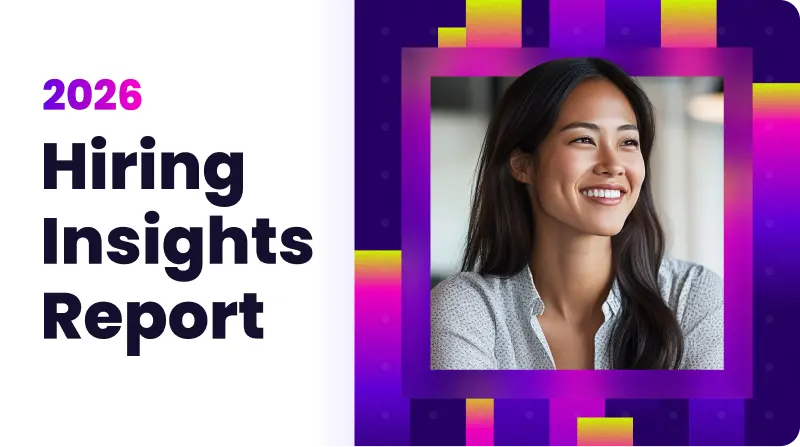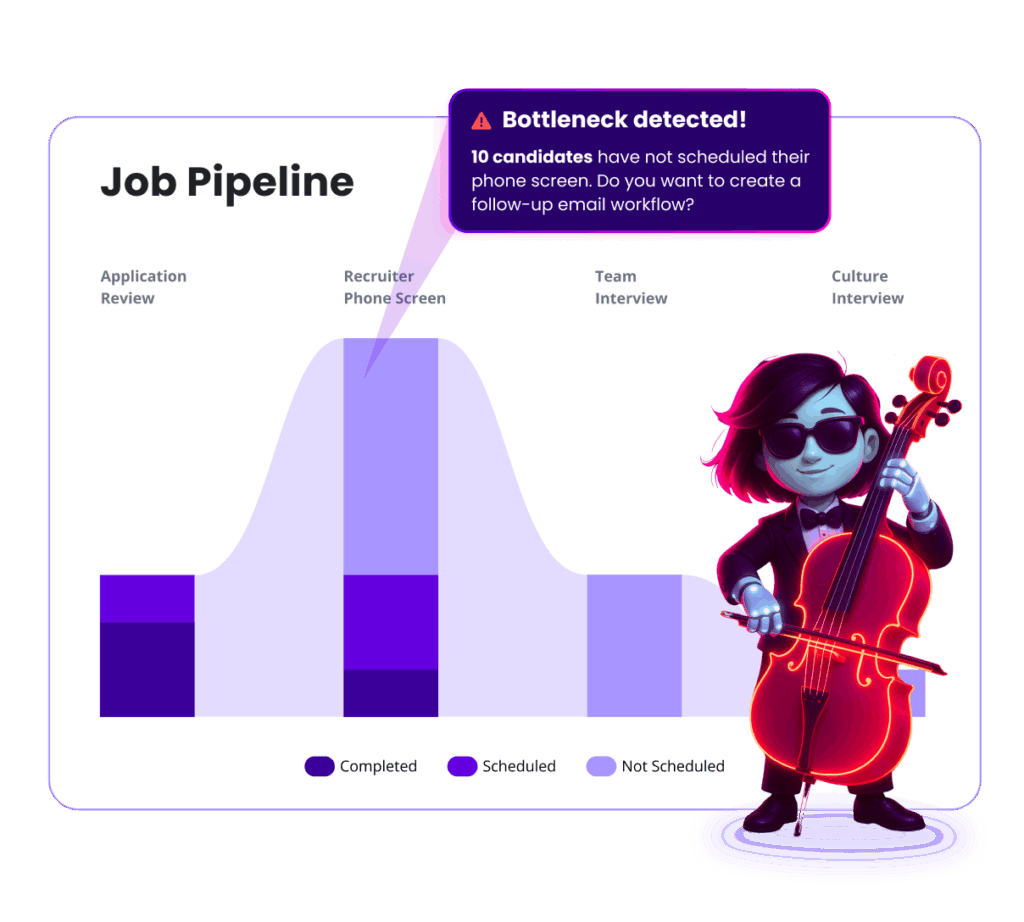Table of Contents
You’ve got a mission-critical role open. Resumes are coming in, the hiring manager is eager, and interviews are underway. Then — quietly — the momentum stalls. A candidate’s feedback is delayed. A scheduler is out sick. A manager sits on approvals for a week. Suddenly, your “ready-to-offer” candidate accepts somewhere else, and you’re back at square one.
It’s the hidden cost of hiring bottlenecks — and it’s bigger than missed deadlines. In today’s market, where top talent is gone in days, pipeline slowdowns are silent killers of hiring velocity, candidate experience, and recruiter morale.

Unlock 2026’s top hiring strategies: Insights from 500+ TA leaders
Be the first to uncover deep hiring insights specific to your sector — straight from the highest-performing TA teams.

Bottlenecks don’t just waste time — they erode trust and opportunity. Every extra day in the pipeline increases the risk of losing top talent to faster-moving competitors. Candidates interpret delays as a sign of disorganization and disengage, sometimes disappearing altogether.
Inside the organization, slowdowns pile extra stress on recruiters and coordinators, forcing them to juggle follow-ups, reschedules, and stakeholder updates instead of building relationships. Hiring managers, frustrated by the lack of progress, may deprioritize their involvement, which in turn slows decision-making further. And beyond the hiring team, there’s a wider business impact: delayed product launches, postponed revenue growth, and teams operating under constant strain because critical roles remain unfilled.
Why bottlenecks often go undetected in traditional systems
One reason bottlenecks are so damaging is that they’re often invisible until it’s too late. Most hiring systems are built to report on what has already happened, not what’s happening right now.
Applicant tracking systems can tell you how many candidates are in each stage, but rarely highlight where or why the process is slowing. Reports surface problems days or weeks after the fact, when the damage has already been done. Finding the root cause often means someone in talent operations manually combing through spreadsheets, chasing updates from multiple stakeholders, and trying to piece together a story from fragmented data.
By the time the slowdown is detected, it has already cost valuable time and, more often than not, one or more top-choice candidates.
The shift toward real-time monitoring with AI agents for bottleneck detection
The most effective talent acquisition teams aren’t waiting for quarterly retrospectives to diagnose problems — they’re building real-time monitoring into their hiring stack. AI agents now play a critical role in this shift.
Instead of relying on lagging reports, AI agents monitor the pipeline continuously, scanning for signs of trouble. They track how quickly candidates move from stage to stage, identify unusual delays, and determine the source of the slowdown — whether it’s unreturned scorecards, unavailable interviewers, or a missing approval. The moment a risk emerges, they alert the team and recommend corrective action.
This proactive approach changes the game. Instead of hearing “we lost the candidate” after the fact, teams hear “your onsite-to-offer time is slipping; here’s how to fix it” while the candidate is still engaged. In a competitive market, that difference in timing is often the difference between a filled role and a lost opportunity.
From reactive to proactive — how AI agents power high-performing TA orgs
Shifting from firefighting to foresight requires a new operating rhythm. High-performing talent acquisition organizations use AI agents not only to detect problems, but to make micro-adjustments before those problems become visible to candidates or hiring managers.
They treat pipeline health as a shared responsibility, with recruiters, hiring managers, and operations teams all working from the same real-time hiring data. That transparency makes it easier to take swift, coordinated action. These organizations also build adaptability into their processes so they can absorb sudden hiring surges or shifting business priorities without the system breaking down.
The result isn’t just faster hiring; it’s a more resilient process. Delays will always be a risk, but with AI-driven detection and proactive management, those delays become small bumps instead of full-blown breakdowns.

Modern AI orchestration: an example in action
This proactive approach to hiring orchestration isn’t theoretical — leading organizations are already using AI agents to keep their pipelines in motion. HubSpot, the global customer platform with over 8,500 employees across 15 countries, is one example.
For Becky McCullough, HubSpot’s Vice President of Talent Acquisition and Mobility, the mission is clear: “At every stage of our candidate life cycle, we need to be really thoughtful about how to drive a great experience for candidates, interviewers, and hiring managers, while also making sure that it is efficient, fast, and driving better outcomes. AI is going to play a key role in automating a lot of those repetitive tasks that can oftentimes slow down a talent acquisition team.”
Before implementing GoodTime’s Orchestra, interview scheduling at HubSpot was slow, manual, and error-prone, often leading to frequent reschedules and burned-out coordinators. By adopting Orchestra, HubSpot standardized and automated its scheduling processes globally, allowing AI agents to detect and address bottlenecks — whether that meant auto-replacing an unavailable interviewer or prompting overdue scorecards — before those slowdowns impacted candidates.
The results have been dramatic: a 75% increase in team productivity, 30% faster scheduling, and a 152% increase in active interviewers. As Becky puts it, “After implementing GoodTime, we’ve not only seen faster interview scheduling — we’ve seen happier candidates, happier interviewers, and a happier coordination team. It’s been the rising tide that has lifted all boats.”
What makes this success sustainable is alignment in AI philosophy. “What stood out to me about GoodTime was how much their AI philosophy aligns with ours,” Becky said. “They are intentional about using AI and automation to eliminate repetitive, mundane tasks. That way, our recruiters, coordinators, and interviewers can spend time building relationships with candidates and connecting with them when and where it matters most.”
HubSpot’s story shows that modern AI orchestration isn’t just about speed — it’s about creating a hiring process that flows seamlessly at a global scale without sacrificing the human connections that make top candidates say “yes.”
The mindset shift TA leaders need to make now
Too many leaders still think of bottlenecks as occasional glitches rather than a constant operational risk. In reality, slowdowns are an ongoing threat, and managing them should be treated as a core TA competency.
Ask yourself: if a bottleneck formed in your process today, how quickly would you know? Would you have the context to act before a candidate felt the lag? Could your team fix it without dropping everything else?
If your answer isn’t a confident yes, it may be time to rethink your approach. Building resilience into your hiring pipeline requires more than better dashboards — it requires systems and AI agents that are watching 24/7, ready to act when early warning signs appear.
Keep your pipeline in flow — not in recovery
The difference between a process that flows and one that fails often comes down to visibility and timing. Bottlenecks are inevitable, but losing candidates, time, and momentum to them is not.
Today’s most competitive talent teams are moving beyond reactive reporting and embracing intelligent orchestration — tools and AI agents that detect, act, and optimize before delays can break the process. Because in hiring, the real cost of a bottleneck isn’t the open role on your requisition list; it’s the opportunities you didn’t seize because your process was too busy fixing itself.




